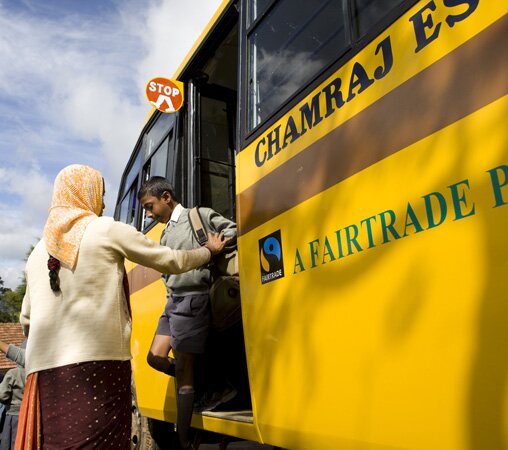12 JUNE - WORLD DAY AGAINST CHILD LABOUR
12.06.2013 - The International Labour Organization (ILO) launched the World Day Against Child Labour in 2002 to focus attention on the global extent of child labour and the action and efforts needed to eliminate it. Each year on 12 June, the World Day brings together governments, employers and workers organisations, civil society, as well as millions of people from around the world to highlight the plight of child labourers and what can be done to help them.
In recent years, Fairtrade International has dedicated considerable resources to strengthening our work to protect children. Child labour is not only a problem perpetuated by poverty and unfair terms of trade; it is also a result of exploitation, lack of access to quality education and social protection, discrimination, conflict, HIV/AIDS and natural disasters, among others.
Child labour is a complex universal issue affecting boys and girls in most countries of the world. According to the International Labour Organization (ILO) there are around 215 million child labourers in the world; around half of them work in hazardous conditions. Risk analyst firm Maplecroft rates 76 countries as at ‘extreme’ risk of child labour.

Child labour refers to work that is harmful to a child’s physical and mental health and well-being, and/or interferes with their education, leisure and development. Child labour does not refer to children or adolescents helping around the house or on the family farm outside of school hours and during school holidays provided that this work is appropriate to their level of development.
International law separates child labour into 3 categories:
- Unconditional worst forms of child labour, such as slavery, commercial sexual exploitation and the use of children in illicit activities;
- Hazardous work, which is to be defined by each country in consultation with workers and employers);
- Labour performed under the minimum age as established by law.
It is estimated that 170 million children and youth work in agriculture. Many of them do not attend any form of school, have little time to play, do not receive proper nutrition or care and more than half of them are exposed to the worst forms of child labour (e.g. work in hazardous environments, slavery, or other forms of forced labour). Many of the types of work girls and boys are involved in are hidden and therefore difficult to track, suggesting that the actual number of child labourers could be much higher, especially for some girls.
Identifying and addressing child labour while respecting the rights of adolescents and youth to appropriate work is important yet challenging. Investing in and ensuring child rights now is both the right thing to do and an investment in the future of agricultural communities.
FAIRTRADE'S APPROACH TO CHILD LABOUR
Fairtrade is committed to fighting the root causes of child labour and proactively preventing the abuse and exploitation of children.
We seek advice and guidance from expert international non-governmental organiSations to ensure that the rights of children are upheld, including their right to live in a safe and protective environment. We work with Fairtrade producer communities to encourage them to establish a child-inclusive, community-based monitoring and remediation system on child labour in partnership with child rights NGOs so that boys and girls in producer communities can enjoy increased well-being.
Putting child protection first , Fairtrade International has instituted a mandatory Child Protection Policy and Procedure for all Fairtrade staff and consultants, which demonstrates our commitment to not only actively preventing child labour, but also ensuring our approach and methods of identifying and remediating the unacceptable work does not cause more harm.
We remain committed to solving children’s real problems and not producing new ones for them. In so doing, we honour our obligations toward the safety and welfare of children. We follow the UN Convention of the Rights of the Child (UNCRC), especially the guiding principles, including “Best Interests of the Child” and note that these should be given primary consideration, in addition to the relevant International Labour Organization Conventions.
A Child-Centered Approach
We believe that children and youth in Fairtrade communities, where possible, should play a central role in empowering themselves and their communities to combat poverty, strengthen their position and take more control over their lives. Our child-inclusive approach builds on the capacity of children and youth in producer communities to contribute to self-monitoring, managing and tackling child labour within their own lives in an on-going, sustainable basis so they become agents of active change in building prosperous lives in agriculture.
How child labour is addressed in the Fairtrade Standards
- Children below the age of 15 are not to be employed by Fairtrade organisations either directly or indirectly;
- Children below the age of 18 cannot undertake in work that jeopardises schooling or the social, moral or physical development of the person;
- Children are only allowed to help on family farms under strict conditions. The work must be age appropriate and be done outside of school hours or during holidays;
- If a small producer organisation is in an area with a high likelihood of child labour, they are encouraged to include a mitigation and elimination plan in their Fairtrade Development Plan;
- If an organisation has identified child labour as a risk, the organisation must implement policy and procedures to prevent children from being employed.
Beyond the Standards
As part of efforts to ensure that producers remain compliant on the requirements of Fairtrade Standards, Fairtrade has been encouraging producers in the informal sectors to take a leadership role in going beyond minimum standard requirements and play a proactive and continuous role to improve the real conditions for children and youth in their communities. Other efforts include:
- Engagement with child rights experts - We are building partnerships with expert organizations and have sought feedback from partners and received their recommendations for developing a rights-based strategy and framework of action for eliminating child labor in key agricultural commodities;
- Focus groups with children in Fairtrade communities - Fairtrade International conducts focus groups with school-going girls and boys in Fairtrade communities to find out about their education, work, future aspirations and the impact of Fairtrade on their lives – essential inputs as we continuously improve our proactive approach to increased wellbeing of girls and boys and young people;
- Training Fairtrade staff - Child labour and child protection training has been given to all relevant staff at Fairtrade International’s headquarters and in producer countries, including liaison officers in all our regions of operations. A second phase of training in countries and commodities identified by the U.S. Department of Labor List of Goods Produced by Child Labour or Forced Labour among others is currently underway.
Explanatory documents
Fairtrade's Position Paper on Child Labour, November 2010
Fairtrade Fights Child Labour, June 2010
Important Links
- Information on the ILO’s International Programme for the Elimination of Child Labour > > > click here
- “Children’s Contribution to Working and Caring for the Land” (PDF) – Published by the Canadian International Development Agency, 2006
- "List of Goods Produced by Child Labor or Forced Labor" (PDF) – Published by the US Department of Labor, 2012
- Mapelcroft List > > > click here
- UN Convention on the Rights of the Child > > > click here
- Child Rights International Network > > > click here



